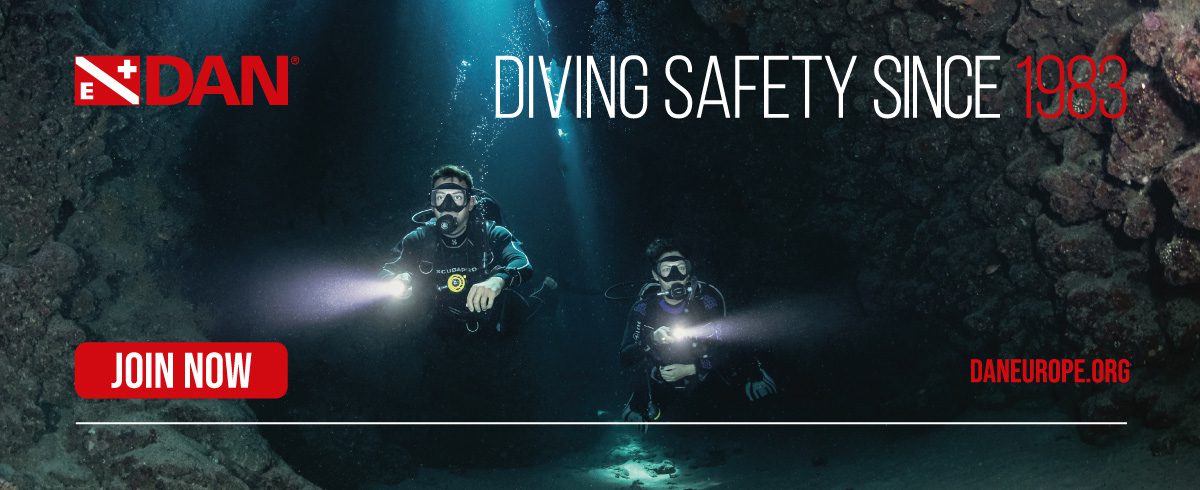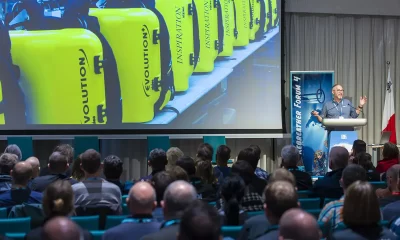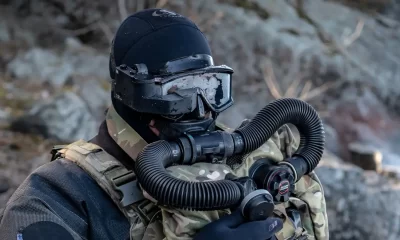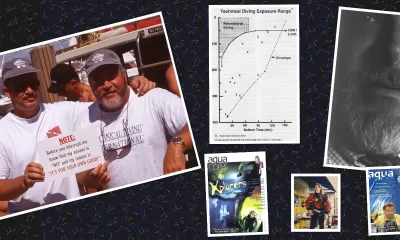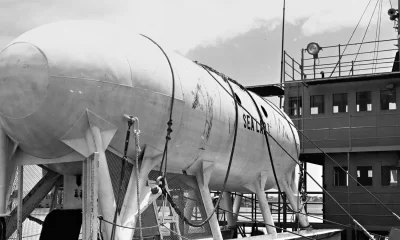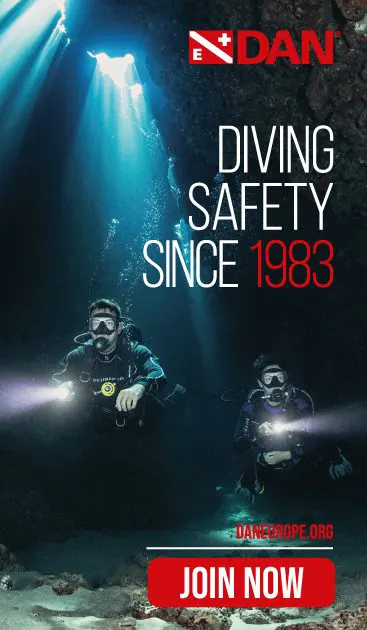
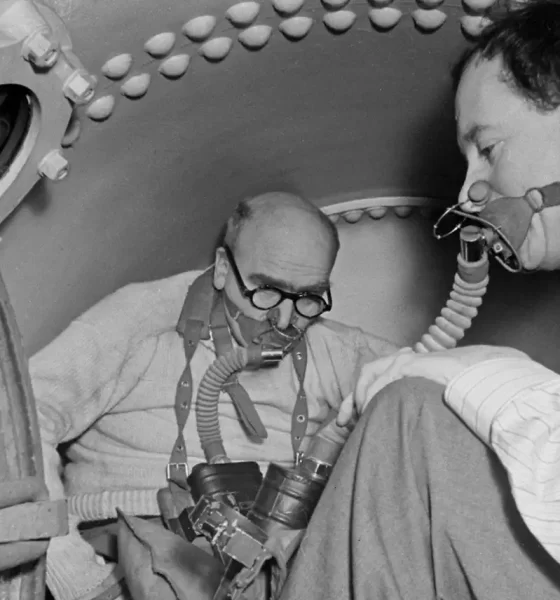
DCS
Meet the D-Day Scientists That Operationalized Self-contained Diving
In an era where tech divers routinely experiment on themselves, the notion that hyperbaric scientists did the same to support WWII’s D-day effort may not seem that far-fetched—though it certainly is from today’s ethical perspective! That’s what makes Dr. Rachel Lance’s new book, Chamber Divers, The Untold Story of the D-Day Scientists Who Changed Special Operations so extraordinary.
Book excerpt by Rachel Lance, PhD. Interview by Michael Menduno. Images courtesy of R. Lance unless noted. Lede image: Drs Martin Case and JBS Haldane preparing for a dive in a test chamber.
Dr. Rachel Lance’s new book, Chamber Divers, is a dive geek page-turner! Based on her exhaustive research (including perusing newly-declassified top secret documents) the 39-year old biomedical engineer and blast injury specialist recounts the story of a band of maverick scientists led by brilliant and controversial British biologist JBS Haldane and intrepid Dr. Helen Spurway, who experimented on themselves despite Nazi air raids in order to work out the physiological limits of breathing gasses.

Their work enabled free-swimming combat divers to safely and effectively carry out their stealthy D-Day missions, which eventually led to the Allied victory. In telling the tale, she upends much of conventional wisdom of the events of the day and deepens our understanding of diving science. Prior to her current position as Assistant Consulting Professor at the Duke University Center for Hyperbaric Medicine & Environmental Physiology, Dr. Lance, who is an avid scuba diver, spent several years working as an undersea engineer for the US Navy where she specialized in the design of diving equipment, including rebreathers, for use by NAVY divers, SEALS, and the Marine Force recon personnel. She is the author of In The Waves, about the mystery surrounding the Civil War submarine, HL Hunley, and was also a presenter at Rebreather Forum 4, where she spoke on the near future of physiological monitoring. InDEPTH reached out to Lance, who kindly provided a breathtaking excerpt from Chamber Divers about oxygen toxicity, and engaged her in a discussion about the book and what we may learn from it. Here then is the excerpt from Chamber Divers, with an intro from Dr. Lance, and what she had to say about it—M2

OxTox Be Docs
On August 19, 1942, a little-known raid by the Allied countries on the French beach town of Dieppe had catastrophic results. Tanks were overturned and burned, vessels sank and drowned their crews inside, and bodies were strewn in horrific numbers across the rocky beaches. The problem – at least one of the problems – was lack of scouting. The raid had been planned using vacation photos of the resort towns taken before the war. The troops running onto the shore were gunned down readily by the Germans.
Turned back by brutal defeat at Dieppe, the Allies knew they would nevertheless need to execute a successful beach landing to take down Hitler on the mainland, but the rout proved they needed beach intelligence. To get that beach intelligence, they decided they needed divers. However, in a time period before Jacques Cousteau’s invention of SCUBA, divers still meant hard hats and support ships, which were hardly a stealth operation.
The British Admiralty turned to Siebe Gorman, a company that made breathing apparatuses for mine rescue and had modified some of the same for use underwater in submarine escape. Siebe Gorman provided the technology, but the devices were largely untested, they needed to be used to see how they could perform before they could be thrown into the frigid waters north of Normandy and counted upon to function well under fire. Testing meant human beings, volunteers willing to climb into hyperbaric chambers and see what the mixture of depth, gasses, and rebreathers would do.
A group of geneticists from the University College London stepped forward. To get what the Allies needed before the day we now call D-Day, they literally volunteered their own bodies. Here is the excerpt:
Scientist-secretary Elizabeth Jermyn puttered around the bottom of the largest water tank at the Siebe Gorman factory southwest of London. It was a hair past noon on a Monday, and she was a veritable marine creature walking about her own underwater zoo. She was preparing for experiment number 170. J. B. S. Haldane, Martin Case, and famed physiologist Sir Leonard Hill, all of whom stood on a dry platform above, peered down at the Jermyn fish in the water.

When Jermyn decided she was ready, she climbed the rungs of the ladder, spat out her mouthpiece, and reported that the Davis Submarine Escape Apparatus (DSEA) seemed to be working well enough for her to use it for a real test. She suspected a slight leak in one valve, but that was normal for this configuration. She walk– sloshed across the second– story platform to the top rim of a smaller, darker tank, a vertical pressure chamber. Haldane, Case, and Hill attached a rope to the back of her harness, which led to a system of pulleys so they could haul her back out in case of emergency.
The Jermyn fish climbed down into the vertical cylinder. She slid through the narrow round hatch at the top of the chamber, first through a compartment of air and then farther into a tall column of cold 65 degree Fahrenheit water, where she continued to breathe like she belonged there. Only a meter or so wide, the hatch itself wasn’t a squeeze for her slight frame, but neither was it spacious. Haldane followed and seated himself on a small platform in the air compartment above her head, letting his feet and legs dangle in her water, his intruding lower limbs protected from the cold by rubber fishing waders.
Someone bolted shut the hefty, circular pressure- proof door at the top. Case was taking notes outside. Haldane had easy access to Jermyn’s rope tether. Her DSEA rebreather was delivering her oxygen as needed. They were ready to start.


Gas began to hiss into the air compartment, pressurizing the space around Haldane and therefore also the water around Jermyn. They reached their goal depth at fifty feet, and Jermyn drifted about happily in her confined space. After six minutes she passed up to Haldane a writing slate with a note saying she was cold but otherwise all right. For another four minutes, Jermyn breathed into her DSEA, feeling the heft of the water push back against her lungs each time she exhaled.
At 12:44 p.m., Haldane bellowed the order to decompress. Now. He bellowed the order to decompress NOW.
The chamber had a small round window in the side, and through it, Case could see the twitching, spastic body of Elizabeth Jermyn. She was having a seizure.
A seizure underwater. Her legs kicked; her hands flailed. She made erratic, ineffective motions like she was trying to climb up Haldane’s legs. Worse yet, she made clutching, desperate gestures that could knock out her own mouthpiece.
Before it began, she had started writing something on the waterproof slate. It wasn’t clear what. She let out a “squeal” or a “squeak.” Then the oxygen took control. And unlike the team’s past experiences with seizures, rather than simply let this one pass on its own, they had to get her out of the water before she could knock out her mouthpiece. If she did that, she would almost certainly drown. Her limbs continued to thrash. They had to get her out now.
The human spinal column is buttressed to the left and right by the erector spinae, a collaborative group of muscles and tendons that work together to unfurl our upper bodies backward and upright. That includes pulling up our bulky heads, which are gargantuan from a zoological perspective, basically lumpy bowling balls of skull and meat. In other words, those muscles are strong. Elizabeth Jermyn’s erector spinae, during the throes of her oxygen convulsion, contracted so hard that those two beefy columns of muscle crushed one of her very bones. Her fifth thoracic vertebral bone, in roughly the center of her spine near the level of her armpits, was fractured.
Over the next few days, she tried to power through the pain. She tried to ignore it. On a visit to Jermyn’s mother’s home, her partner Nari Bamji badgered her into a proper medical exam, like a good partner should, and X-rays confirmed the diagnosis that her back was literally broken.
Jermyn’s bone fractured in place, and none of the bone fragments shifted or displaced. So she recovered fully, if you don’t count the disabling back pain that would plague her for the rest of her life. (She didn’t.) However, it takes only one half of an inch of compression to explode an entire bone in the spine. The human spine is so flexible in bending that a person’s face can fully smack into their chest without damage to the bones or spinal cord. It will cause a hell of a case of whiplash and muscle strain, but no damage to the bones themselves. In pure compression, though, one half inch will fracture an entire vertebral bone into ragged shards. Those ragged shards often sever the spinal cord in the process, disrupting the traveling electrical impulses that dance down that long, bundled string of nerves to allow our brains to control our bodies as puppeteers do with dancing dolls.
As of the dawn of 1942, the United States Navy gave a limit of two hours for oxygen at fifty feet, and the Royal Navy copied it. Jermyn had lasted ten minutes. So few divers had used oxygen for free- swimming diving that, luckily, those air-based guidelines had gone largely untested in water. As recently as six weeks before Jermyn’s seizure, Haldane had written: “I have also heard at last from Lieutenant Commander Behnke in America. It is fairly clear from his letter that half an hour [of oxygen] at ninety feet would be safe for most people at any rate.” Jermyn’s seizure proved they were wrong. All of them.

The Interview with Rachel Lance
InDEPTH: What inspired you to write a book about World War II hyperbaric scientists?
Rachel Lance: A couple of things. I wanted to write a book about scientists who experimented on themselves because this is a common practice in science, which I find fascinating. I wanted to provide non-scientists with a story about how that works, what it looks like, and why people do it. At the time, I had been exploring stories about scientists experimenting on themselves and had a compilation of stories over a couple hundred years.
I talked to my agent about it, and she suggested I focus on one story because it makes it easier for people to stay engaged through the whole book. I had this paper from JBS Haldane that was published in 1941. He and his team had tested the effects of CO2 on themselves.

That’s the son of John Scott Haldane, right? The man who originally formulated decompression theory in the late 1800s.
That’s right. The more I thought about that story, the more the date really bothered me because they were being bombed in 1940. There was something about carbon dioxide that was important enough for this guy to work on while they were being bombed in the labs as they were doing it. That was intriguing enough for me that I really wanted to follow that thread further. Once I figured out they were working on D-Day, that just blew every other story candidate out of the water.
I got the distinct impression that much of this information was new. I hadn’t seen this story in print before.
That’s correct. So much of this is new and newly declassified that nobody in our professional field has even heard this story before, even though today we still use the scientific results. Researchers in my field will learn where ideas that are commonly accepted today, like oxygen toxicity, originally came from along with all the other people reading this book. I’m actually taking a lot of the data points from this research group, and turning them into a new academic paper about oxygen toxicity risk.

Fascinating. That’s really good. I was impressed by your research, which was exhaustive. I mean, you have almost 100 pages of notes and references in a 420-page book. You’re a geek Rachel.
[Smiles and rolls her eyes] It’s actually over 100. I think there are 123 pages of references, which means you get the satisfaction of having read a giant book, without actually having to read the whole book.
Ha! There you go! So how has researching and writing this book changed your understanding of hyperbaric research and how we got where we are today?
I always thought hyperbaric research was important to divers and submariners, but this research for the book emphasized to me how important it’s been in changing the world. Obviously, there were many factors that led to the end of World War II, but one critical aspect of Allied victory in D-Day (and therefore World War II) was hyperbaric research. They inarguably changed the world as a result of diving science.
I was surprised how little was known at the time about the physiological effects of gasses under pressure. And they were being driven by the need to put combat divers in the water and in subs for the war effort, right?
That’s exactly right. Before that, there hadn’t been a lot of need for physiology because it had been almost exclusively hardhat diving. Once they figured out the major protocols for avoiding decompression sickness for hardhat divers in the early 1900s, they didn’t really deal with the other problems because they didn’t need to for surface supplied diving. It was because the Allies needed to deploy free swimming divers that they had to revolutionize the way they understood the science, because the divers were carrying their own life support systems on their backs.


Or their front! This is when oxygen rebreathers were coming into their own.
Yes, that’s true. They did have front and back mounted configurations. Absolutely right. I was being a bit more abstract. Yes!
But weren’t O2 rebreathers invented before the turn of the century, by Henry Fleuss I think, at Siebe Gorman.
Yeah, but here’s the crazy part. They had never really been tested under pressure and had not been tested in water. They had been originally built for mine rescue, which obviously has limited oxygen toxicity potential, and then they had been adapted for underwater use for submarine escape.
When submarines started going down, because there was a lack of knowledge about CNS oxygen toxicity, the original guidelines for oxygen rebreathers were what we would now consider to be insane. They were claiming things like, it was fine to use down to 200 feet on pure O2. I think that the Navy guidelines allowed two hours at 15 m/50 ft on pure O2. So their understanding of oxygen toxicity was absent. They hadn’t been experiencing O2 hits because the submarine sinkings and the submarine escapes were so rare that they hadn’t encountered it yet.

Gotcha. Whereas with the war, they wanted to send in stealthy self-contained divers, so that forced them to really have to look at how these things perform underwater?
Exactly. With the war, when they started trying to use them intentionally, people started dying.
Shades of rebreather diving! Were there any surprises in your research? Any something that came out, you know, like, “Oh shit, I can’t believe that?” That kind of stuff?
So many, so many. One of my favorite things, this is probably gonna sound minor, but one of the favorite things that I found was records of the first time that the English-speaking world was testing fins. They were all just swimming normally, and they sometimes had hand fins. Nobody had put them on their feet, at least, that’s what their records indicate. The Brits actually captured an Italian diver who had foot-attached fins during World War II. That’s the first time I’ve seen a record of the English-speaking world saying that it was their first experience using dive fins, which I’d never, ever thought about.
Wow. I would have thought fins had been in use for hundreds of years in some fashion or the other??
There are probably other records, but at least in terms of the way the British military talked about it, it was the first time they’d seen the idea.
You’ve selected an excerpt from the book (shown above) about the early experiments determining the limits of oxygen and oxygen toxicity. Why this excerpt and what did you find most intriguing about these early efforts to understand oxygen limits?
I like this excerpt for the diving community because I think oxygen toxicity is one of these monsters that we’ve simply avoided because the consequences are too high. Decompression sickness has something like a littoral area for injuries, right? Meaning, there’s this theoretical beach area where you can kind of segue between the safe zone and the danger zone of DCS risk, and divers are risk takers, so sometimes they’ll flirt with the edges of the dangerous practices just to see what it’s like and to see if they get hurt. Many divers who engage in this behavior end up with mild DCS and then decide not to proceed further. With oxygen toxicity, however, there’s no such intermediate area. You’re either fine or you’re VERY not okay.
So, I really wanted to tell this story about oxygen toxicity because I think reading about what these researchers experienced is one of the only opportunities that many divers are going to have to understand oxygen toxicity better in a way that doesn’t put them at risk.


Reading the excerpt, I mean, I doubt these experiments would receive a pass from a University ethics committee on experimentation, right? It was just incredible.
The researchers didn’t know what would happen. They thought it was a completely safe test. That’s one of the things about scientific research—you have to be prepared for anything, any possible outcome. And that’s exactly what happened. Because of them, and because they experienced it first hand, we now know a lot more about oxygen toxicity that we can use to keep divers safe. Since we have the luxury of knowing what happened to them, no, these tests would never pass an ethics committee today.
The researcher, Elizabeth Jermyn, was actually injured from the convulsion, right?
Yeah, she seized so hard that the muscles in her back fractured one of the bones in her spine. She had back pain for the rest of her life. Because that vertebra was already fractured, if she’d done another test and had another similar seizure, it is possible that it would have fully broken apart and severed her spinal cord. Thankfully, she got X-rays first.
Is it a truism that scientists don’t experiment on themselves anymore, right? Did something change in science? Was that just something people did back then and don’t do now?
What changed in science was actually the Nazis. Because the discovery of the concentration camps revealed these horrifying, now-infamous scientific experiments using unwilling subjects, we now have an international code of ethics for scientific research. That code came directly out of the Nuremberg Trials.
One of the principles that’s very important in science today is to never use data from yourself to draw conclusions. The reasons for that are because you are a biased observer. If I really want an experiment to work, it doesn’t even have to be intentional, but I could subconsciously be trying to bias the data. So now as scientists, we have these principles of blinding where the subject does not know what they’re getting. Ideally, the scientist does not know what the subject is getting either, so they can’t accidentally give clues.
We also use subjects who have no interest in the outcome of the experiments.
Many scientists do still test preliminarily on themselves to see if an idea might work or to see if a setup works. I test my own setups all the time just to make sure they’re safe and okay to use. I’ve never asked a test subject to experience something that I haven’t tried first, because I think it’s important that I be able to honestly describe to them what they’re signing up for. But scientists cannot use the data from ourselves anymore.
The other thing I found interesting after reading all the work that was done on oxygen is that there’s still a lot we don’t know, right? I mean researchers like Israel’s Dr. Ran Arieli or Dr. Barbara Shykoff from the US Navy Experimental Diving Unit (NEDU), are still trying to figure out the workings of pulmonary oxygen toxicity.
That’s absolutely true. We have a fundamental understanding of generally what’s happening, which is that oxygen is this highly reactive molecule and it’s somehow—oxygen and its species—affecting the nervous system. What we don’t understand is specifically what part of the nervous system it’s affecting. We don’t understand the differentiation between pulmonary and CNS oxygen toxicity.
There’s some indication that pulmonary is actually a result of nervous system poisoning too, except it’s just showing up in the lungs first. And we definitely don’t know how to stop it. This World War II group was able to do these experiments in the danger areas because of the extremity of the war. But now, obviously, it’s really ethically problematic to push people to these same limits, without the context of Nazis everywhere.


Interestingly, I was talking about this with freediving pioneer Kirk Krack, who founded Performance Freediving International (PFI), which is now a part of International Training (IT). The question was, how will we ever determine oxygen breath hold limits for tech freedivers?
Can you breathe pure oxygen at the surface and then do a freedive to 30 m/100 ft without seizing? Most likely yes. Can you do it 10x in a row? Maybe, maybe not. But how do we figure out those limits? I mean, you would never get the experiment passed the ethics board, right?
Right. I can actually tell you the answer because of the World War II researchers/divers! When they first noticed that oxygen toxicity was causing seizures—which again, was a brand new discovery at this time—one of the first things they did was to see if they could essentially outrun it. So, they were making chamber dives down to 200 feet, down to 300 feet, pressurizing as fast as humanly possible. They would either start at the surface breathing oxygen, or dive then just taking a breath or two of pure oxygen, before ascending to a shallower depth to see if they could kind of outrun it.
A surprising number of these experiments ended okay. They did determine that essentially making a fast descent rate or free diving, you still have a lung full of oxygen, so you still would be susceptible to toxicity, but your risk increases with the length of time you’re breathing it.There is a very clear relationship with the length of time you’re breathing it. We (nerd folk) are not able to provide a recommendation mathematically yet, but it’s clear that your risk increases the longer you’re breathing.
So, a single breath of pure oxygen on a bounce free dive down to 90 meters might be fine. Might be. Or it might not. The WWII scientists did it and they were fine sometimes, but then other times they weren’t. That’s the real beast of oxygen toxicity; it’s very unpredictable when it will hit.
There was something else that struck me. I have had Kenneth Donald’s book, Oxygen and the Diver, for I don’t know, decades, right? All these years I had been thinking, he was the guy who brought us knowledge of oxygen limits. But it was really the Haldane team with Jermyn and Case that did all the work, and it appears in retrospect, that Donald was the one that politically got the credit for it.
Yeah. Essentially, he outlived the rest of the group. He did pretend in his book that he was the lead of the diving team, which was not true. It was William O. Shelford. Donald took credit from Shelford for that, and then he also didn’t make any of those plots that are in his book. He plagiarized the statistical analysis verbatim from Dr. Helen Spurway. She was the one who actually analyzed all of the data and drew all the conclusions. When I traced it back to the original military reports, her contribution for that was extremely clear. But he worked for the military, so he was able to bury her original reports. He took credit for all of it in his book, and he didn’t give credit to anybody else.

Wow! I know there’s still politics in hyperbaric medicine, heck all medicine, right? How do the politics of that time compare to the politics today? Have we gotten better, or is it pretty much the same?
I feel like it can be pretty much the same, but it depends on the group. To me, Donald’s story is emblematic of the bad part of interpersonal drama, and how it can have a negative effect on scientific progress. But what he did can be contrasted against the University College of London (UCL) lab, who achieved great things because they all worked together. Kenneth Donald’s story shows how such infighting impedes progress, because between WWII and when he published his book in 1991, he didn’t add anything new to the field despite fifty extra years to work. Instead, we need to focus on the groups and the connections that are working together smoothly because that’s where progress comes from.
So, as a result of the research done during WWII, our knowledge grew exponentially. Where are we today? Are there still many big things left that we don’t know yet, that we will need to know? How do things look today in terms of discovery compared to that period? Are we almost there or we still have a way to go?
I would feel scared to say we’re almost there, because then I might be expected to deliver on that promise. I think the main difference today is that we have a good understanding of what’s safe. This group during World War II was trying to understand what’s safe so that the divers didn’t die, and they were successful. They had zero casualties among their diving population that used their science. That’s a huge deal, right?
A fundamental reason why recreational diving is so safe is because we’re able to hand divers a set of information that says, here’s what you cannot do and here’s where you will be safe. Now with tech diving, obviously people start to push that envelope and blur the limits. That’s the region where we still have a lot of research to do, and most dive research today focuses on, okay, how do we push that safe limit further? That’s what we’re working on in the labs. Part of extending safe limits involves better understanding of how things like oxygen toxicity and DCS happen on a physiological level, so research into those fundamentals is important too.
I am reminded of a great quote from retired US Master Diver Sam Huss for a story I did on the NEDU, “We make our divers safer so they can go deeper and stay longer,” he said.

Rachel, what would you like readers to take away from the book?
Every data point is a person. Every time you ask for more information about oxygen toxicity or decompression sickness or hydrogen diving, every data point is a person who stepped up and agreed to go first and try it, no matter the consequences.
Wow, yeah, that’s a good one. We stand on the shoulders of giants, right?
Exactly. We stand on the shoulders of scientific volunteers.
Hear hear! What’s next for Rachel Lance? Where are your research interests taking you next?
I’ve used the Chamber Divers’ data to start an oxygen toxicity database of scientifically conducted exposures, and yes I am accepting data points from other labs if they’d like to contribute! I cannot take points from non-research dives because the variability in depths is too great, so I’m trying to keep the dataset to controlled, scientific dives. Eventually I’ll make that database public, after I’ve processed the statistics.
Interesting! I look forward to seeing that.
Thanks! I’m also working on a third book and with Divers Alert Network (DAN) on some diving sensor projects.
That’s great. We need them. So where can readers find “Chamber Divers?”
It’s available for sale pretty much everywhere that sells books. You can find it here at: Amazon US or Amazon UK. I also have a number of book seller links at the bottom of the page on my website CHAMBER DIVERS.
Get the book people! Thank you so much Rachel!
DIVE DEEPER
NPR: Seizures, broken spines and vomiting: Scientific testing that helped facilitate D-Day Interview with Rachel Lance by Terry Gross
Wired: They Experimented on Themselves in Secret. What They Discovered Helped Win a War by Rachel Lance. The untold, top-secret story of the British researchers who found the key to keeping humans alive underwater—and helped make D-Day a success.
GUE.TV: RF4 Presentation—Near Future of Physiological Monitoring by Rachel Lance
Wired: How to Escape From a Sunken Submarine by Rachel Lance. First of all, you can’t just open the hatch when you’re trapped at the bottom of the ocean. But there is a way out—it requires physics and some audacity.

Michael Menduno/M2 is InDepth’s editor-in-chief and an award-winning journalist and technologist who has written about diving and diving technology for more than 35 years. He coined the term “technical diving.” His magazine “aquaCORPS: The Journal for Technical Diving” (1990-1996) helped usher tech diving into mainstream sports diving, and he produced the first tek.Conferences and Rebreather Forums 1.0 , 2.0, and 4.0. In addition to InDepth, Menduno serves as Senior Editor for DAN Europe’s Alert Diver magazine. He is a member of the Rebreather Training Council (RTC).








